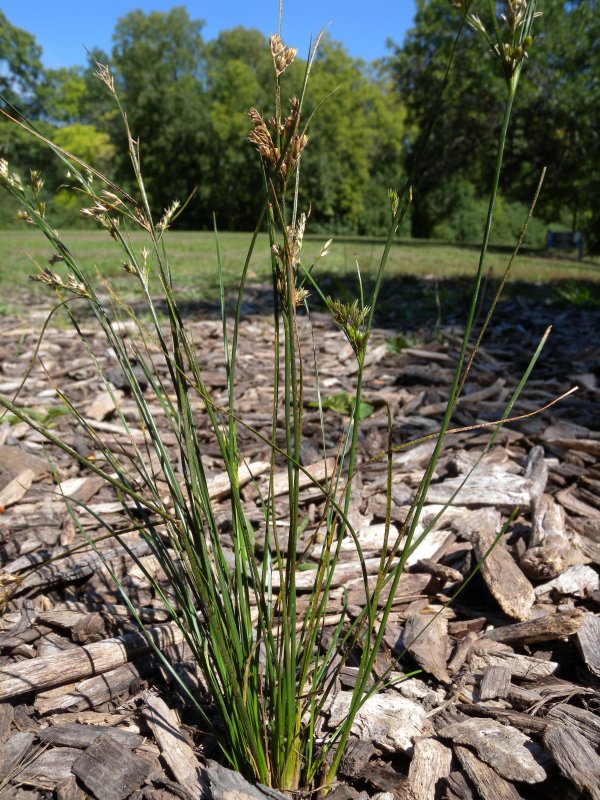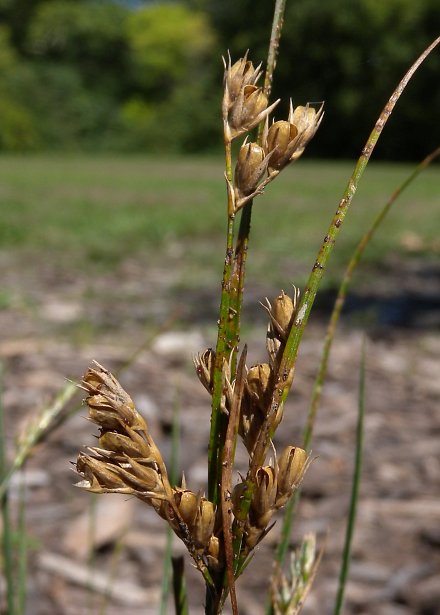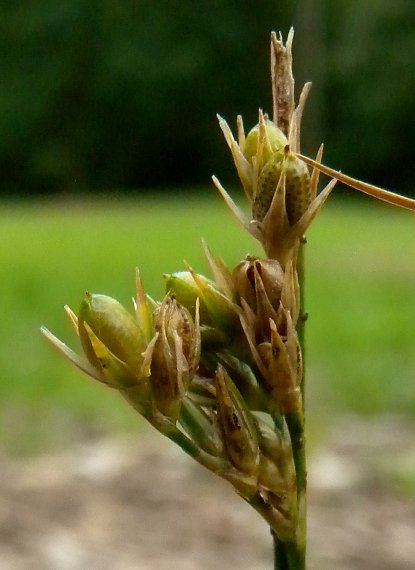
Individual flowers are 3-4.5 mm. long and about one-half as much across; their tepals and ovaries are about the same length. Each flower has 6 tepals, 6 stamens, and an ovary with a single style. The tepals are lanceolate in shape with membranous margins; immature tepals are green, but they later become light brown. The ovary of each flower is ovoid to ovoid-oblongoid in shape; the immature ovary is green, but it later becomes light brown. Both the tepals and ovary are glabrous. At the base of each flower, there is a pair of short linear bractlets. At the base of entire inflorescence, there are about 3 leafy bracts of variable size; these bracts are linear in shape and ascending. The blooming period occurs from early summer into the autumn; individual flowers remain in bloom for only a short time and they are cross-pollinated by the wind. Afterwards, the flowers are replaced by seed capsules that are the same size as the ovaries, except they may be slightly more elongated and oblongoid in shape. Eventually, these capsules divide into 3 parts to release their tiny seeds. The seeds are up to 0.5 mm. long and brown; they are easily blown about by the wind. The root system is fibrous.

Cultivation: The preference is full sun to light shade, wet to mesic conditions, and poorly drained soil containing some clay or rocky material. This rush can spread aggressively in some areas and it is difficult to pull out by the roots.
Range & Habitat: Inland Rush is common throughout Illinois, where it is native (see Distribution Map). It is widely distributed in eastern North America. Habitats include moist prairies, prairie swales, seeps, depressions in rocky glades, soggy meadows, paths in open woodlands, ditches along roadsides and railroads, overgrazed pastures, grassy areas in parks, and poorly maintained lawns. Inland Rush prefers areas with a history of disturbance. It has low fidelity to any particular habitat.

Faunal Associations: Insects that feed on the similar Path Rush (Juncus tenuis) probably also feed on Inland Rush. Examples of such insects include the Short-winged Meadow Katydid (Conocephalus brevipennis), which feeds on the seed capsules, and the Juncus Mealybug (Dysmicoccus junceus), which feeds on the roots. Other insects that may feed on these rushes include aphids (Prociphilus corrugatans, Rhopalosiphum nymphaeae), the larvae of some Agromyzid flies (Cerodontha spp.), and larvae of the Javelin Moth (Bactra verutana); see Gangwere (1961), Blackman & Eastop (2013), Spencer & Steyskal (1986), Miller (1987), and others. Among vertebrate animals, the seedheads are probably eaten by ducks and other waterfowl, while the foliage of Inland Rush is usually avoided by cattle, Canada Geese, and other herbivores because of its high silicon content (Lanning, 1972; personal observations). The tiny seeds of this rush can probably cling to the muddy feet and feathers of waterfowl, as well as the fur of mammals, especially when they are wet. In addition, people probably spread the seeds by means of their muddy shoes, mowing activities, and the wind of passing motor vehicles.

Photographic Location: A grassy lawn at Crystal Lake Park in Urbana, Illinois. While Canada Geese are avid consumers of Kentucky Bluegrass (Poa pratensis) and other kinds of lawn grass at this site, they ignored the coarse foliage of Inland Rush. This selection effect, combined with infrequent mowing of the lawn, enabled this rush to spread and establish itself.
Comments: The Inland Rush (Juncus interior) is occasionally found in either disturbed or poorly drained areas of prairies. It is a relatively small and ordinary-looking rush that can be difficult to distinguish from other rushes (Juncus spp.), especially the Path Rush (Juncus tenuis) and Dudley's Rush (Juncus dudleyi). The easiest way to distinguish these rushes involves an examination of the membranous auricles (uppermost margins) of their basal sheaths. The auricles of Inland Rush are rounded and soft. In contrast, the auricles of Path Rush are strongly exserted and narrowly triangular in shape, while the auricles of Dudley's Rush are rounded and hardened. There is a tendency for the Path Rush to be slightly smaller in size, while Dudley's Rush tends to be slightly larger in size. The mature seed capsules of Inland Rush tend to be more oblongoid in shape than those of the other two rushes.